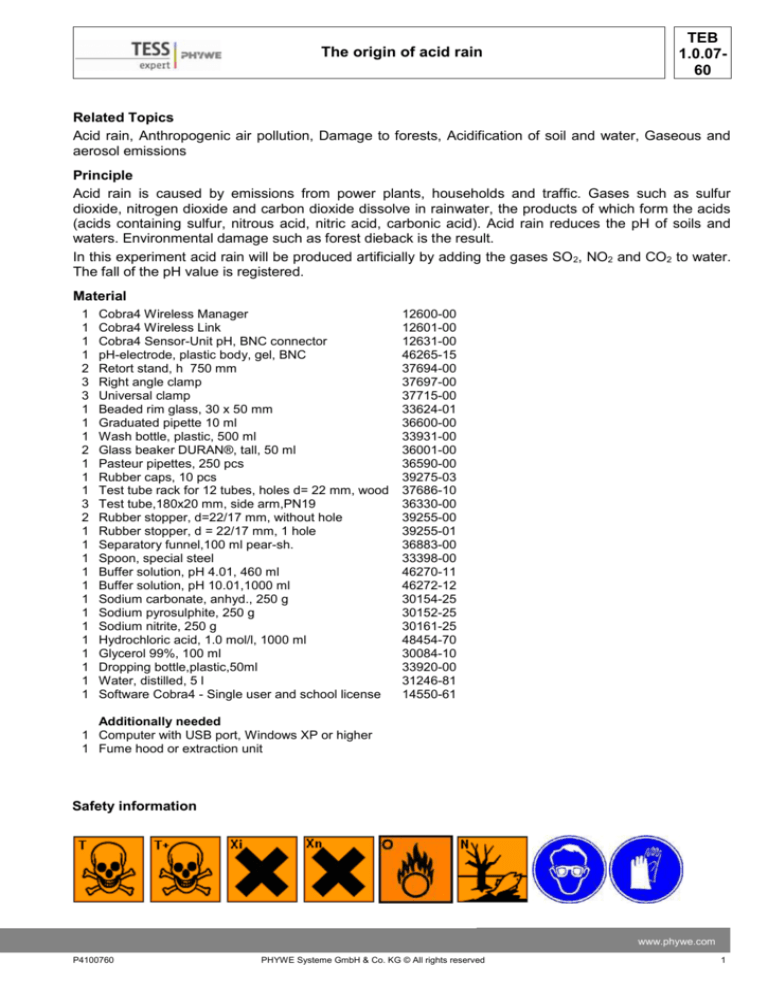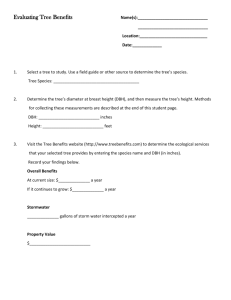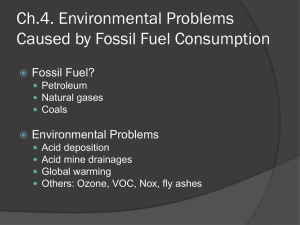
The origin of acid rain
TEB
1.0.0760
Related Topics
Acid rain, Anthropogenic air pollution, Damage to forests, Acidification of soil and water, Gaseous and
aerosol emissions
Principle
Acid rain is caused by emissions from power plants, households and traffic. Gases such as sulfur
dioxide, nitrogen dioxide and carbon dioxide dissolve in rainwater, the products of which form the acids
(acids containing sulfur, nitrous acid, nitric acid, carbonic acid). Acid rain reduces the pH of soils and
waters. Environmental damage such as forest dieback is the result.
In this experiment acid rain will be produced artificially by adding the gases SO 2, NO2 and CO2 to water.
The fall of the pH value is registered.
Material
1
1
1
1
2
3
3
1
1
1
2
1
1
1
3
2
1
1
1
1
1
1
1
1
1
1
1
1
1
Cobra4 Wireless Manager
Cobra4 Wireless Link
Cobra4 Sensor-Unit pH, BNC connector
pH-electrode, plastic body, gel, BNC
Retort stand, h 750 mm
Right angle clamp
Universal clamp
Beaded rim glass, 30 x 50 mm
Graduated pipette 10 ml
Wash bottle, plastic, 500 ml
Glass beaker DURAN®, tall, 50 ml
Pasteur pipettes, 250 pcs
Rubber caps, 10 pcs
Test tube rack for 12 tubes, holes d= 22 mm, wood
Test tube,180x20 mm, side arm,PN19
Rubber stopper, d=22/17 mm, without hole
Rubber stopper, d = 22/17 mm, 1 hole
Separatory funnel,100 ml pear-sh.
Spoon, special steel
Buffer solution, pH 4.01, 460 ml
Buffer solution, pH 10.01,1000 ml
Sodium carbonate, anhyd., 250 g
Sodium pyrosulphite, 250 g
Sodium nitrite, 250 g
Hydrochloric acid, 1.0 mol/l, 1000 ml
Glycerol 99%, 100 ml
Dropping bottle,plastic,50ml
Water, distilled, 5 l
Software Cobra4 - Single user and school license
12600-00
12601-00
12631-00
46265-15
37694-00
37697-00
37715-00
33624-01
36600-00
33931-00
36001-00
36590-00
39275-03
37686-10
36330-00
39255-00
39255-01
36883-00
33398-00
46270-11
46272-12
30154-25
30152-25
30161-25
48454-70
30084-10
33920-00
31246-81
14550-61
Additionally needed
1 Computer with USB port, Windows XP or higher
1 Fume hood or extraction unit
Safety information
www.phywe.com
P4100760
PHYWE Systeme GmbH & Co. KG © All rights reserved
1
TEB
1.0.0760
The origin of acid rain
Fig. 1: Producing acid rain
During this experiment toxic gases are created by chemical reactions. The experiment is therefore to be
performed under a well-functioning fume hood and it must be ensured that these gases do not reach the
classroom.
Hydrochloric acid is very corrosive or irritating depending on the concentration. Vapors irritate the
respiratory organs, whereby the mucosal tissue of the upper respiratory organs are extremely affected.
Concentrated acids destroy skin and textiles.
Sodium carbonate forms a white scent-free crystal, which dissolves very well in water. The aqueous
solutions react strongly alkaline. With acids carbon dioxide is released from the solid as well as from the
aqueous solutions.
Hazards: Sodium carbonate irritates the eyes and mucosal tissue.
Safety information: Avoid contact with eyes and skin. Do not inhale dust particles. While working, it is
necessary to wear adequate protective clothes, protective gloves und safety goggles.
Disposal: Dilute solutions with water, neutralize (pH 6-8) and pour down the drain.
Sodium carbonate forms a colorless to slightly yellow hygroscopic crystal, which dissolves very well in
water. The aqueous solutions react alkaline. With acids nitrous gases are released from the solid as well
as from the aqueous solutions. In the event of fire sodium nitrite is oxidizing and hazardous combustion
gases or vapors can form.
2
PHYWE Systeme GmbH & Co. KG © All rights reserved
P4100760
The origin of acid rain
TEB
1.0.0760
Hazards: Sodium nitrite is poisonous when swallowed and very poisonous for water organisms. Danger
of fire avoid contact with flammable materials.
Safety information: Avoid contact with eyes and skin. Do not inhale dust particles. While working, it is
necessary to wear adequate protective clothes, protective gloves und safety goggles. In the event of an
accident or if you feel ill consult a physician immediately (if possible show the label of the chemical
packaging). Avoid contact with the environment and ask for special instructions/ consult the safety data
sheets.
Disposal: Small amounts of sodium nitrite can be placed directly into a collection container for anorganic
acids, bases and salts. Larger quantities are to be oxidized with an aqueous potassium permanganate
solution to nitrates and then also added to this collection container.
Sodium disulfide forms a nearly scent-free stable in air crystals, which dissolve very well in water. The
aqueous solutions react alkaline. With acids the toxic gas sulfur dioxide is released from the solid as well
as from the aqueous solutions.
Hazards: Sodium disulfide is harmful to health when swallowed and irritates the eyes, respiratory organs
and skin.
Safety information: Avoid contact with eyes and skin. Do not inhale dust particles. While working, it is
necessary to wear adequate protective clothes, protective gloves und safety goggles. In the event of
contact with the eyes, immediately rinse out thoroughly and consult a physician.
Disposal: Place solutions and solid residue in a collection container for anorganic waste (acidic and
alkaline) and dispose of properly. Make sure that the content of the collection container always has an
alkaline pH value.
Carbon dioxide is a colorless and odorless non-flammable gas which dissolves well in water. The
aqueous solutions react acidic.
Sulfur dioxide is a poisonous, colorless, strong-smelling non-flammable gas. It is very irritating to the
eyes and respiratory tract.
Hazards: Toxic when inhaled. Causes chemical burns.
Safety information: Do not inhale gas. Avoid contact with eyes and skin. While working, it is necessary to
wear adequate protective clothes, protective gloves und safety goggles and if necessary respiratory
protection. Store containers with sulfur dioxide in a well-ventilated area. In the event of an accident or if
you feel ill consult a physician immediately (if possible show the label of the chemical packaging). In the
event of contact with the eyes, immediately rinse out thoroughly and consult a physician.
Sulfur dioxide is a highly toxic, reddish-brown, strong-smelling, non-flammable gas. It is very irritating to
the eyes and respiratory tract. Even brief periods of exposure can be dangerous and mild or even
unnoticed inhalation can lead to edema formation in the lungs even after several days.
Hazards: Toxic when inhaled. Causes chemical burns.
Safety information: Do not inhale gas. Avoid contact with eyes and skin. While working, it is necessary to
wear adequate protective clothes, protective gloves und safety goggles and if necessary respiratory
protection. Store containers with nitrogen dioxide in a well-ventilated area. In the event of an accident or
if you feel ill consult a physician immediately (if possible show the label of the chemical packaging). In
the event of contact with the eyes and skin, immediately rinse thoroughly with water and consult a
physician.
First aid: If it comes in contact with the skin or eyes, rinse thoroughly with water with wide open eyelids.
In the event of eye injuries consult a physician immediately. In the event of an accident or if you feel ill
consult a physician immediately. In the event of inhalation: Seek fresh air, and keep the respiratory tract
www.phywe.com
P4100760
PHYWE Systeme GmbH & Co. KG © All rights reserved
3
TEB
1.0.0760
The origin of acid rain
clear. In the event of shortness of breath: Transport to the
physician in a semi-upright position.
Preparatory work
Creating gases using gas developers:
3 pasteur pipettes are labeled with SO2, NO2 and CO2.
The separatory funnel is labeled with HCl and a rubber
stopper with hole placed on it (Fig.2). Attention: Slide
funnel through the stopper only with the support of a
lubricant (e.g. glycerin).
In three test tubes with side arms enough Na2S2O5,
NaNO2 or Na2CO3 is added with the spoon so that the
round bottom of the test tubes is filled. All three test
tubes are placed in the fume hood in a test tube rack.
The separatory funnel is filled half full with hydrochloric
acid 1 mol/l and carefully placed in the test tube with
Na2S2O5 (see Fig. 2). The test tubes with NaNO2 und
Na2CO3 are then sealed with rubber stoppers.
Setup and implementation
The setup is performed according to Fig. 3.
Connect the Cobra4 Wireless Links with Cobra4
Sensor-Unit pH.
Fig. 3: Experiment set up
Start the computer and Windows
Plug the Cobra4 Wireless Manager into the computer’s
USB port.
Connect the pH electrode with the Cobra4 Wireless-Link and switch on. The pH electrode is
automatically recognized: It is assigned an ID number, which is visible in the display of the Cobra4
Wireless-Link. The communication between the Cobra4 Wireless
Manager and the peripheral Cobra4 Wireless Link is shown on the
LED Data.
Start the software “measure Cobra4” on the computer.
Load “The origin of acid rain” experiment (Experiment > Open
experiment). All pre-settings required for directly recording the
measurement readings are now loaded. This allows the pH value to
be automatically displayed depending on the time during the
measurement.
Calibrate the pH electrode, when doing so add both buffer solutions
in two 50ml glass beakers.
Call up in the navigator <pH/Potential pH> and select <Calibration>.
If the electrode used has already been recently calibrated, it does
not have to be re-calibrated (calibration data are automatically
saved).
Fill beaded rim glass with 10ml of tap water and fasten with the
universal clamp on the retort stand.
Attach pH electrode with the universal clamp so that it is completely
submerged in the water and positioned a few millimeters from the
bottom of the beaded rim glass.
Fig. 2: Production of gases
In the fume hood: Carefully open the separatory funnel and add 40
4
PHYWE Systeme GmbH & Co. KG © All rights reserved
P4100760
The origin of acid rain
-
-
-
-
-
TEB
1.0.0760
drops of HCl into the test tube with Na2S2O5 and wait several minutes until the SO2 gas created has
displaced the air in the test tube.
Completely press the pipetting ball of the SO2 pipette together, carefully insert the tip of the pipette
in the side arm of the test tube with Na2S2O5 and slowly extract the SO2 gas created.
Carefully insert the SO2 pipette (do not press the pipetting ball!) into the test tube next to the pH
electrode until the bottom of the test tube is reached.
Start the recording of the measurement with measure .
After approx. 10 seconds press the pipetting ball and allow the entire SO2 gas to slowly bubble
through the water of the beaded rim glass.
If the pH value remains constant, terminate the measurement .
After the measurement select “transfer all measurements to measure”.
Afterwards create CO2 gas by adding drops of HCl from sodium nitrite NO2 gas or from sodium
carbonate.
In the same manner as described above, the measurement is repeated with NO2 and CO2 (Rinse
beaded rim glass and pH probe thoroughly with distilled water beforehand!)
Result and Evaluation
-
-
-
-
Fig. 4 shows the pH time curves for SO2, NO2 and CO2, after they have been merged in the menu
“measurement” with “accept measurement channel”.
After adding the gas to the water the pH value drops since acid is formed in the water: H2SO3 with
SO2, HNO2 and HNO3 with NO2, and H2CO3 with CO2. The exact value of the pH drop results by
clicking the button <Display Extrema> or <Measure>.
For SO2 the drop in pH value is most distinct, followed closely by NO2. The pH value is only slightly
lowered in the experiment with CO2. The values can vary depending on the acidity of the tap water
and the amount of gas added.
Which gases are principally responsible for the acidification of precipitation can only be assessed
after taking emission quantities into consideration.
Fig. 4:
pH time curve for SO2, NO2 and CO2
www.phywe.com
P4100760
PHYWE Systeme GmbH & Co. KG © All rights reserved
5
TEB
1.0.0760
The origin of acid rain
Room for notes
6
PHYWE Systeme GmbH & Co. KG © All rights reserved
P4100760








